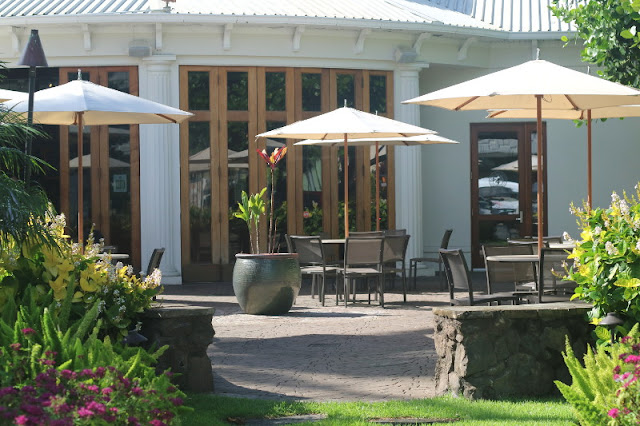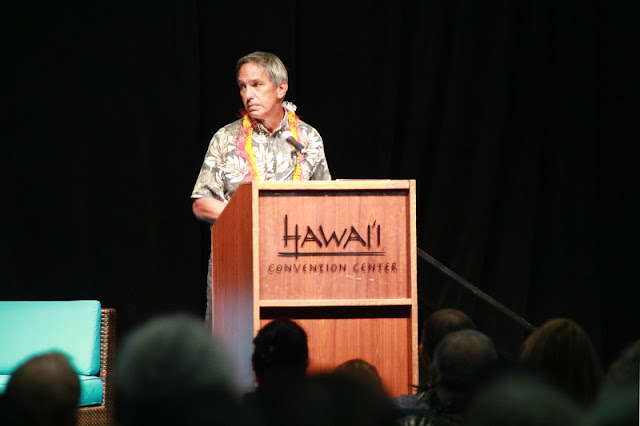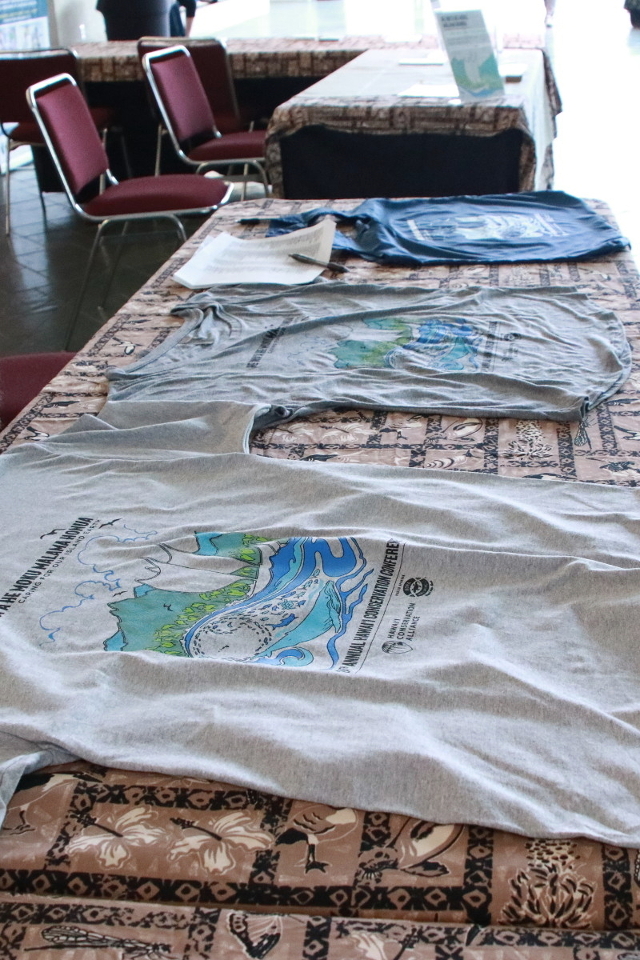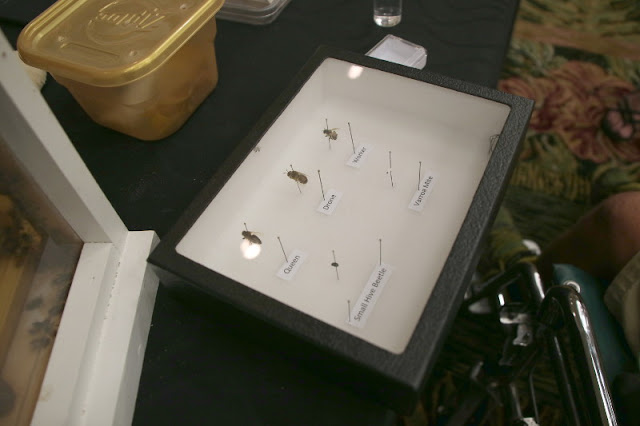 |
| One must cross three crosswalks to start the day on the right side (of the Convention Center, if you exit the Convention Center from the main point of egress, where there is great espresso and acai bowls). |
 |
| But those that make the journey are rewarded with this inviting outdoor dining space, a surprisingly rare commodity in Honolulu given its unrivaled year-round weather. |
 |
| Three rooms of people showed up to hear Nainoa Thompson give the opening keynote. Conch shells were sounded as he entered the room, and as he left the stage to a standing ovation. Tucked away in his stories were poetic and poignant gems of wisdom that made us wish we had taken notes. |
 |
| Attendees were asked to take a photo and visually link it to the place they represent or feel most connected to. |
 |
| Ruud Kleinpaste gave an entertaining keynote on Day 2, calling us all to action and keeping the audience laughing. Many people remarked that his talk was the highlight of their day. |
 |
| Everyone was stoked about the graphic design of the t-shirts this year. |
 |
| The difference in appearance of queen, drone, and worker bees, plus a small hive beetle and varroa mite: just one of the many fascinating things to see in the exhibition hall. |
 |
| Achatinella diversity, another. |
 |
| About an entire day's worth of sessions were devoted to Rapid Ohia Death, including a demonstration on the proper way to collect ʻōhiʻa seeds in the field and submit them for storage. |
There were fifteen fifteen-minute talks about Rapid Ohia Death (ROD) plus about half a day of training on
ʻōhiʻa seed collection and a Q&A lunch session about ROD, so that seems like a good place to start. Please remember I am a layperson and each talk was only fifteen minutes long with almost no time for questions.
ROD apparently became a known problem around 2013, and has, as of May 2017, affected 75,000 acres of forest on the Big Island. The latest news is that there are two species (strains?) of fungi new to science (or just Hawaii? the implication to me was new to science) that each cause a disease of
ʻōhiʻa. One causes a wilt and the other a canker. Although I'm pretty sure it was said that there were two new
species, reference was made over and over again to the culprit fungus as
Ceratocystis fimbriata, which is the long-known fungus that is notorious for causing disease in some agricultural crops, but which someone stated does not cause disease on
ʻōhiʻa (they tested this) and did not evolve into new pathogens (how do they know this?). It was said that the wilt disease is a globally infamous tree decimator, while not much is known about the canker, but it seems like a paradox that this can be true on one hand while on the other the disease and pathogens are both new... Perhaps there are two strains of
C. fimbriata new to Hawaii, the wilt causing strain being the notorious tree assassin and the canker causing strain being the stealthy mysterious one. That is not what I heard, but that is the most plausible story I can deduce from the scrawl fragments I have.
Most of the discussion centered around the
C. fimbriata (strain?) that causes
ʻōhiʻa wilt, which leads me to believe that this one is having a significantly larger impact. This pathogen spreads by ambrosia beetles or by moving wood around. There are four ambrosia beetles that go after
ʻōhiʻa, one of which is native to Hawaii (
Xyleborus simillus). The main beetle of concern is
Xyleborus ferrugineus. The spores stick to the beetle's body, or in the case of at least
X. ferrugineus, the spores can be transported around in the beetle's gut (new discovery), and I suppose they pass through the digestive tract with their viability intact. As these beetles burrow into the woody plant parts, they generate frass, which can also carry spores and become airborne or fall into the soil. Contaminated frass can cause disease in
ʻōhiʻa only if it comes in contact with a wound on the tree (recent study findings). I think the severity of staining on the wood correlates with disease severity.
Someone found there were more viable spores in the lower (under six feet height) portion of
ʻōhiʻa trees than upper (above six feet high), and that the window of viability for these spores is small (why?).
Another interesting finding is that older stands have higher mortality rates than younger stands.
Because the spores have potential to become airborne, air currents are being modeled (to predict potential paths of spread to guide management decisions?).
A lot of people are monitoring the health of individual trees in different ways and at different scales. Aerial surveys are being conducted every three to twelve months on the Big Island, with on-ground follow-ups to diagnose ROD. Drones are flown monthly over certain transects to identify spatial and temporal trends in ROD spread. Statewide surveys have also been done. There is an ESRI group for ROD. There was also reference to an app used to aggregate spatial ROD data and an effort to use modeling to identify areas where ROD may spread to in the future. It sounded like major efforts were targeting control in the northern Big Island region because wind patterns in that region track towards Maui, which would be a potential way of it moving up the island chain.
The main practical takeaways from all of this were clean your gear, don't move wood around, and do not injure the trees.
Despite the sad state of affairs, I am comforted by the fact that there are a lot of smart people working on this.
Here are some other interesting things I heard:
- Twenty-two new plant (species?) are naturalized each year in Hawaii.
- Taxonomic, ecological and geospatial data are drawn on to prioritize which invasive species to target for eradication.
- Mangroves were introduced to Hawaii over a hundred years ago (missed what the reason for introduction was). It's invasive in this state. All estuaries state-wide are invaded (not sure if this was a general statement or specifically referring to mangrove presence and extent). Paragrass can cover 1.3 square meters per day in Hawaii. Sedge marshes consisting of species like Cyperus laevigatus (makaloa) and Schoenoplectus californicus (ʻakaʻakai) were probably the major vegetation cover type prior to invasion. There is a pilot project underway where mangrove was cleared and native marsh plants like the ones above are being planted.
- Albizia (Falcataria moluccana) was introduced to Hawaii by Joseph Rock in 1917 and is the fastest growing tree in the world. There are a few different potential biocontrols. The ones given the most airtime at the conference were a gall rust fungus and eriophyid mite that is so difficult to identify that only one person in the world can really do it.
- The endangered honeycreeper ʻakikiki cracks open ʻōhiʻa capsules with its beak (to get at food?).
- Walked in on this presentation pretty late, but the speaker referred to a "leaf smoothie" concocted from the wild relative Phyllostegia mollis, somehow applied to plants of Phyllostegia kaalaensis, a rare endemic prone to powdery mildew, that seems to confer some degree of resistance to this disease (due to the microbiological stuff that's in the P. mollis plant, not sure precisely what). Magical! How does this work?!
- Kahoʻolawe has eleven wetlands. Restoration plantings are surficial; digging is a bad idea due to potential unexploded ordinance.
- I speculated about the decline of Pandanus forest in the past, and am sad to learn this is probably true (but maybe not for the reasons I thought). The Pandanaceae family has 800 species and five genera. There are thirty-six species known to occur in Hawaii, of which two are native: Pandanus tectorius (hala) and Freycinetia arborea (ʻieʻie). Somewhere there exists maps of "pre-human" and current distributions of P. tectorius. There is a scale (Thysanococcus pandani; links to a PDF doc) that affects Pandanus. It was discovered in Hana, Maui in 1995 and came from Southeast Asia.
Please feel free to post any corrections or additional information in the comments below.
